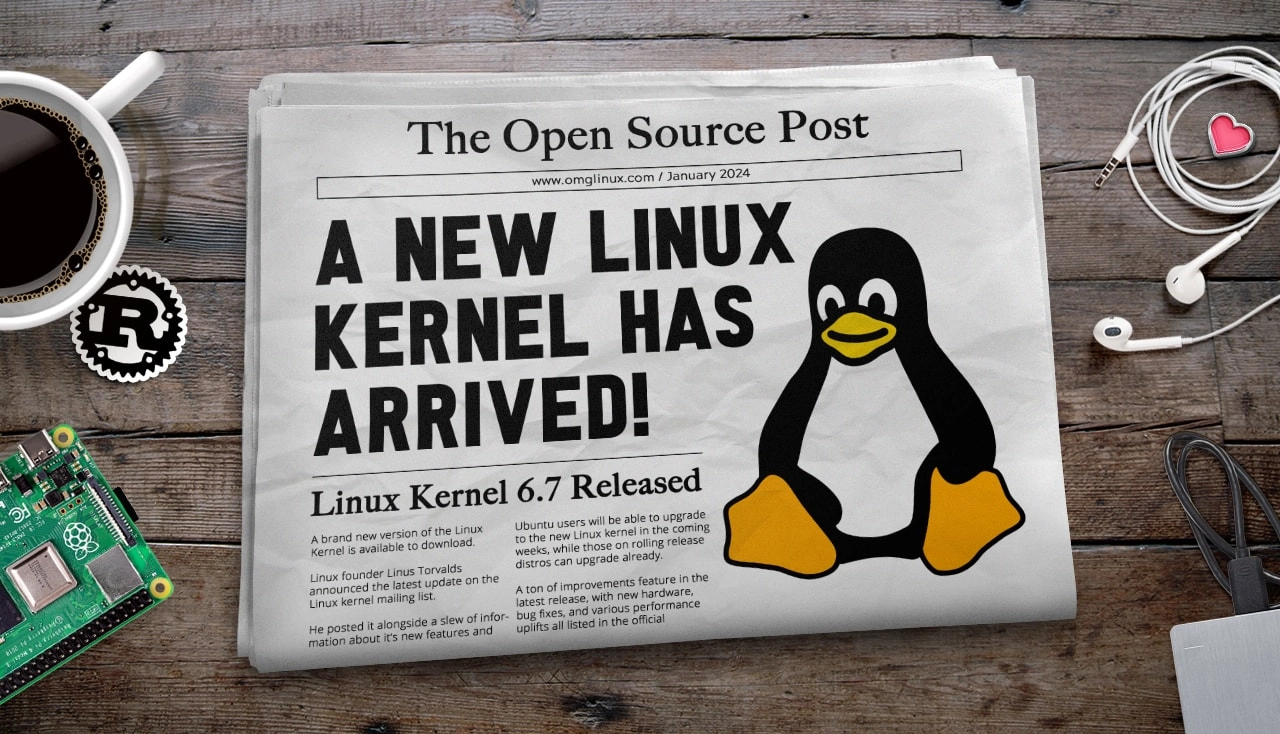A new year, and an all-new Linux kernel to help power it along!
Yes, the Linux 6.7 kernel is now officially released — and it’s a substantial one, packed with a variety of new features, new hardware enablement, and more.
Based solely on commit size, Linux 6.7 is one of the largest in recent history. This is an indication of just how much effort has been invested in refining the latest release.
Linus Torvalds mentions this in his release announcement.
“We had a little bit more going on last week compared to the holiday week before that, but certainly not enough to make me think we’d want to delay this any further. End result: 6.7 is (in number of commits: over 17k non-merge commits, with 1k+ merges) one of the largest kernel releases we’ve ever had”
Linus Torvalds
Let’s dive in to what’s swelling out those commits…
What’s new in Linux 6.7?
A list of new features and enhancements in Linux 6.7:
- Experimental Bcachefs filesystem now in mainline kernel
- Option to enable/disable 32-bit emulation on x86-64 kernels
- Intel Meteor Lake graphics support is now enabled by default
- NVIDIA GPU System Processor (GSP) firmware support
- DP Alt Mode 2.1 support in USB Type-C driver
- AMD Seamless Boot now works with wider range of AMD hardware
- F2FS now able to support larger page sizes
- Btrfs buffs, including temporary file-system ID support
- AppArmor access control to io_uring and creation of user namespaces
- KVM gains support for virtualisation of LoongArch
- KVM on RISC-V supports the Smstateen extension
- Rust bindings for workqueues, upgrade to Rust 1.73 toolchain
- Long list of improvements/features added to
perftool - Ancient videobuf layer removed
- Logitech HID++ tweaks
- ASUS WMI driver adds Screenpad support
Bcachfe said to be ‘safer than btrfs, faster than zfs’
Part of the reason this kernel has seen a lot of commits is due to the addition of (still somewhat experimental) Bcachefs. This bills itself as “an advanced new filesystem for Linux, with an emphasis on reliability and robustness and [a] complete set of features”.
It’s said to offer several compelling lures versus existing dominant file systems like ext4, which is used by Ubuntu, including checksumming and multi-device functionality within a filesystem, is said to be ‘safer to use’ than btrfs, and faster than zfs — sounds like one to watch!
Valve helps levels up btrfs
Of the 3 new Btrfs features included in Linux 6.7 the addition of FSID (temporary file-system ID) will garner most interest. Igalia’s Guilherme Piccol worked on this feature at the request of Valve, who are looking to leverage it in their Linux-based Steam OS on the Steam Deck.
To quote Guilherme, FSID allows “…systems with A/B partitioning scheme (like the Steam Deck console or various mobile devices) to be able to hold the same filesystem image in both partitions”.
Graphics gains galore
NVIDIA GSP firmware is also a notable addition, as Phoronix says it brings better power management and performance for GeForce RTX 20 and RTX 30 series hardware (when running with proprietary firmware blobs), as well as RTX 40 acceleration in Nouveau setups — nice!
Intel Meteor Lake graphics support in Linux 6.7 is now considered stable, which is great news. But, as ever, progress never stops! To this end, a glut of graphics bringup for Intel Xe 2 Lunar Lake integrated graphics ships in this release.
Intel Itanium IA-64 support dropped (for now)
I can’t imagine it’s going to affect any folks who read this site, but the Linux 6.7 kernel drops support for the Intel Itanium IA-64 architecture — completely! All code has been removed from the kernel tree. Naturally, some folks aren’t happy about this. Linus is sanguine, adding:
“I’d be willing to resurrect itanium support, even though I personally despise the architecture with a passion for being fundamentally based on faulty design premises, and an implementation based on politics rather than good technical design … But only if it turns out to actually have some long-term active interest…”
For more details on everything included in this Linux kernel release I highly recommend sifting through through the comprehensive LWN merge window summaries (part 1, part 2).
Getting Linux 6.7
New Linux kernels aren’t automatically packaged up and released to existing versions of Ubuntu.
When it comes to interim releases, the kernel series that is included at the time of release is the one it adheres to. Although Ubuntu Long-Term Service (LTS) releases receive updated versions of Linux kernels, these are often backported. And since currently, not a single Ubuntu release utilizes the 6.7 version, there’s nothing available for backporting.
It is indeed possible to install a new primary Linux kernel in Ubuntu and its derivatives, such as Linux Mint. This can be done through mainline kernel builds, which are created by Ubuntu developers (Note: at the time of writing, the v6.7 version isn’t available but expected to appear soon).
However, it should be noted that Ubuntu’s primary kernel builds are not intended for everyday users like us. They come without support, may not have certain kernel-enabled patches normally present in regular Ubuntu Linux kernel releases, may have bugs or idiosyncrasies, etc. Therefore, if you choose to use them, proceed with caution.
